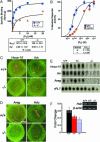Cochaperone immunophilin FKBP52 is critical to uterine receptivity for embryo implantation
- PMID: 16176985
- PMCID: PMC1242310
- DOI: 10.1073/pnas.0505775102
Cochaperone immunophilin FKBP52 is critical to uterine receptivity for embryo implantation
Abstract
Embryo implantation in the uterus is a critical step in mammalian reproduction, requiring preparation of the uterus receptive to blastocyst implantation. Uterine receptivity, also known as the window of implantation, lasts for a limited period, and it is during this period blastocysts normally implant. Ovarian steroid hormones estrogen and progesterone (P(4)) are the primary regulators of this process. The immunophilin FKBP52 serves as a cochaperone for steroid hormone nuclear receptors to govern appropriate hormone action in target tissues. Here we show a critical role for FKBP52 in mouse implantation. This immunophilin has unique spatiotemporal expression in the uterus during implantation, and females missing the Fkbp52 gene have complete implantation failure due to lack of attainment of uterine receptivity. The overlapping uterine expression of FKBP52 with nuclear progesterone receptor (PR) in wild-type mice together with reduced P(4) binding to PR, attenuated PR transcriptional activity and down-regulation of several P(4)-regulated genes in uteri of Fkbp52(-/-) mice, establishes this cochaperone as a critical regulator of uterine P(4) function. Interestingly, ovulation, another P(4)-mediated event, remains normal. Collectively, the present investigation provides evidence for an in vivo role for this cochaperone in regulating tissue-specific hormone action and its critical role in uterine receptivity for implantation.
Figures





Similar articles
-
Proteomic analysis identifies immunophilin FK506 binding protein 4 (FKBP52) as a downstream target of Hoxa10 in the periimplantation mouse uterus.Mol Endocrinol. 2005 Mar;19(3):683-97. doi: 10.1210/me.2004-0332. Epub 2004 Nov 4. Mol Endocrinol. 2005. PMID: 15528267
-
Uterine FK506-binding protein 52 (FKBP52)-peroxiredoxin-6 (PRDX6) signaling protects pregnancy from overt oxidative stress.Proc Natl Acad Sci U S A. 2010 Aug 31;107(35):15577-82. doi: 10.1073/pnas.1009324107. Epub 2010 Aug 16. Proc Natl Acad Sci U S A. 2010. PMID: 20713718 Free PMC article.
-
FK506-binding protein 52 is essential to uterine reproductive physiology controlled by the progesterone receptor A isoform.Mol Endocrinol. 2006 Nov;20(11):2682-94. doi: 10.1210/me.2006-0024. Epub 2006 Jul 27. Mol Endocrinol. 2006. PMID: 16873445 Free PMC article.
-
Progesterone receptor requires a co-chaperone for signalling in uterine biology and implantation.Reprod Biomed Online. 2006 Nov;13(5):651-60. doi: 10.1016/s1472-6483(10)60655-4. Reprod Biomed Online. 2006. PMID: 17169175 Review.
-
In vivo analysis of progesterone receptor action in the uterus during embryo implantation.Semin Cell Dev Biol. 2008 Apr;19(2):178-86. doi: 10.1016/j.semcdb.2007.12.001. Epub 2008 Jan 6. Semin Cell Dev Biol. 2008. PMID: 18280760 Review.
Cited by
-
GCUNC-45 is a novel regulator for the progesterone receptor/hsp90 chaperoning pathway.Mol Cell Biol. 2006 Mar;26(5):1722-30. doi: 10.1128/MCB.26.5.1722-1730.2006. Mol Cell Biol. 2006. PMID: 16478993 Free PMC article.
-
Progesterone and Estrogen Signaling in the Endometrium: What Goes Wrong in Endometriosis?Int J Mol Sci. 2019 Aug 5;20(15):3822. doi: 10.3390/ijms20153822. Int J Mol Sci. 2019. PMID: 31387263 Free PMC article. Review.
-
Mouse primary uterine cell coculture system revisited: ovarian hormones mimic the aspects of in vivo uterine cell proliferation.Endocrinology. 2011 Aug;152(8):3246-58. doi: 10.1210/en.2011-0223. Epub 2011 Jun 21. Endocrinology. 2011. PMID: 21693674 Free PMC article.
-
Accelerated neurodegeneration through chaperone-mediated oligomerization of tau.J Clin Invest. 2013 Oct;123(10):4158-69. doi: 10.1172/JCI69003. Epub 2013 Sep 3. J Clin Invest. 2013. PMID: 23999428 Free PMC article.
-
Stress-induced sex differences: adaptations mediated by the glucocorticoid receptor.Horm Behav. 2012 Aug;62(3):210-8. doi: 10.1016/j.yhbeh.2012.02.024. Epub 2012 Mar 3. Horm Behav. 2012. PMID: 22426413 Free PMC article. Review.
References
-
- Paria, B. C., Reese, J., Das, S. K. & Dey, S. K. (2002) Science 296, 2185-2188. - PubMed
-
- Dey, S. K., Lim, H., Das, S. K., Reese, J., Paria, B. C., Daikoku, T. & Wang, H. (2004) Endocr. Rev. 25, 341-373. - PubMed
-
- Mulac-Jericevic, B., Mullinax, R. A., DeMayo, F. J., Lydon, J. P. & Conneely, O. M. (2000) Science 289, 1751-1754. - PubMed
-
- Silverstein, A. M., Galigniana, M. D., Kanelakis, K. C., Radanyi, C., Renoir, J. M. & Pratt, W. B. (1999) J. Biol. Chem. 274, 36980-36986. - PubMed
-
- Barent, R. L., Nair, S. C., Carr, D. C., Ruan, Y., Rimerman, R. A., Fulton, J., Zhang, Y. & Smith, D. F. (1998) Mol. Endocrinol. 12, 342-354. - PubMed
Publication types
MeSH terms
Substances
Grants and funding
LinkOut - more resources
Full Text Sources
Other Literature Sources
Molecular Biology Databases
Research Materials
Miscellaneous

